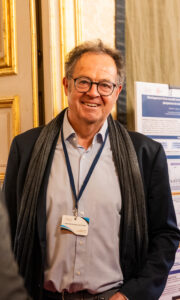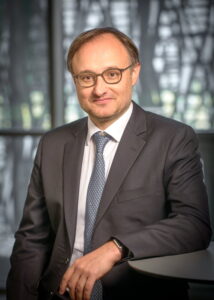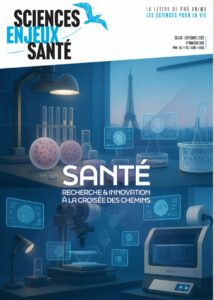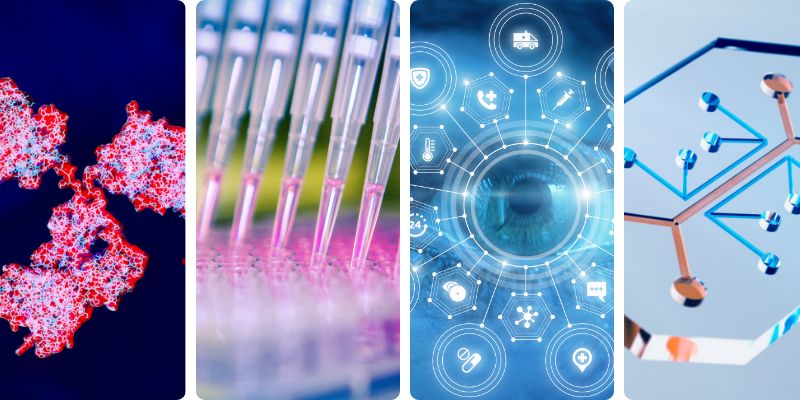Organoids, Organs-on-a-Chip, AI, current and upcoming challenges in France?
Technological innovation is constantly redefining the boundaries of research and medicine, promising spectacular advances in diagnosis, treatment, and prevention. In this issue, we wanted to explore the dynamics driving current research, particularly the challenges surrounding organoid and organ-on-chip (O&OoC) technology. France, through the France 2030 funding plan, allocated €48.4 million in 2024 to a major project: the PEPR MED-OOC, co-led by the CEA, the CNRS, and Inserm, which aims to develop a new generation of biological models through the development of O&OoC. O&OoC stakeholders have also organized at the national level through a Strategic Sector Contract (F3OCI). At the heart of our discussions, Jean-Dominique Guitton, co-pilot of the O&OoC sector, and Franck Mouthon, executive director of the health research program agency (APRS) entrusted to Inserm, share their visions on the (often complex) issues that mark the innovation journey. We also discussed the competitiveness and sovereignty of French research in a European and globalized landscape, as well as the potential of O&OoC in the face of artificial intelligence (AI) in drug discovery.
In light of these transformations, what are the programmatic challenges for France? What obstacles remain to be overcome, and what future prospects are emerging for more efficient and collaborative health research? Through this double voice exclusive interview, the two experts share their perspectives and experiences to shed light on the levels of action to build the research of tomorrow.
Pro Anima Scientific Committee: What is your role and specific connection with health research and the development of new technologies such as organs-on-chips? How did you become involved in or interested in this topic?
Jean-Dominique Guitton : I co-lead, with Thibault Honegger, the Organoids and Organs-on-a-Chip theme of project 14 “Energizing and structuring the players in preclinical and clinical research in France” of the Strategic Contract for the Industry and Health Technology Sector (CSF-ITS). I have spent my entire career in research in the pharmaceutical industry (Aventis, Sanofi) and I joined the BioValley France cluster at the end of 2014. At BioValley France, we began to take an interest in organ-on-a-chip technology in 2018 with the idea of setting up a structuring project around this technology based on the needs of the pharmaceutical industry.
After a series of meetings with manufacturers initially, then by integrating biotechs and finally academic teams, we were able to observe that few people working in the OoC field knew each other and we decided to try to set up a French community by launching the development of a directory, by planning a workshop entitled “Towards the creation and structuring of the sector” which took place in February 2022. Before this workshop, we had contacted the Ministry of Research and thanks to its support we were able to present our idea of structuring the sector to the ANSM (National Agency for the Safety of Medicines and Health Products), to the AIS (Health Innovation Agency) then to the FEFIS (French Federation of Health Industries) and to France Biotech, meetings which allowed the inclusion of this theme in the new CSF-ITS.
Franck Mouthon : I’m a scientist by training, a graduate of the École Normale Supérieure (ENS). I worked for time in neurovirology at the Pasteur Institute. I then led a research team on prion diseases, particularly Creutzfeldt-Jakob disease, in the context marked by the mad cow crisis. In this context, I was able to explore the most fundamental aspect: neuron-glia interactions. The work carried out with my team, particularly with Mathieu Charvériat, has led to the identification of new therapeutic targets located at the interface between neurons and glial cells.
This breakthrough led, within the framework of the CEA’s spin-off programs, to the creation of Theranexus, a biotechnology company dedicated to the development of drug candidates in the field of pediatric neurological diseases1.
This breakthrough led, as part of the CEA’s spin-off programs, to the creation of Theranexus, a biotechnology company dedicated to the development of drug candidates in the field of pediatric neurological diseases.
In parallel with this entrepreneurial adventure, I led and chaired France Biotech, a professional federation bringing together entrepreneurs in biotech, medtech, and digital healthcare. In this role, which I took on at the end of 2019, I actively contributed to the development of public-private partnerships with the government, as well as to strengthening technology transfer in healthcare. This experience took place in a context marked by the health crisis, which particularly highlighted the importance of these dynamics of innovation and cooperation.
I was also heavily involved in preparing the 2021 Strategic Council for Health Industries (CSIS), co-developing with the French government numerous proposals that informed the France 2030 Health Innovation Plan. This plan served as a precursor to the whole France 2030 plan. At the same time, I was appointed a France 2030 Qualified Person for the health innovation component.
In April 2024, I left my various operational roles — presidency of France Biotech and general management of Theranexus—to become executive director of the Health Research Programs Agency (APRS). This Agency, entrusted to Inserm for the health field, aims above all to be a catalyst: its mission is to adopt a programmatic and strategic vision of research*, consistent with the desire expressed by the President of the Republic to structure thematic agencies in several key areas — space, food, digital technology, energy, climate, and health.
��As part of France 2030, France had already chosen a certain number of priority programs (PEPR) in acceleration strategies or outside of strategy. The PEPR MED-OOC is one of these major national programs. The agencies, in their areas of expertise, are taking over the operational management, scientific and strategic steering of these major programs. It is also because a technological transition in the health sector is currently taking place that this subject interests me. It remains uncertain to anticipate precisely what will become of this program, but it is important now to define the trajectory that could be assigned to it, whether scientific, medical or industrial, and to specify its strategic positioning. This field is part of a dynamic of major technological transition: it offers the possibility of accelerating certain developments, reducing risks, crossing critical stages, limiting the use of animal experiments and providing responses to vulnerabilities that have remained out of reach until now.
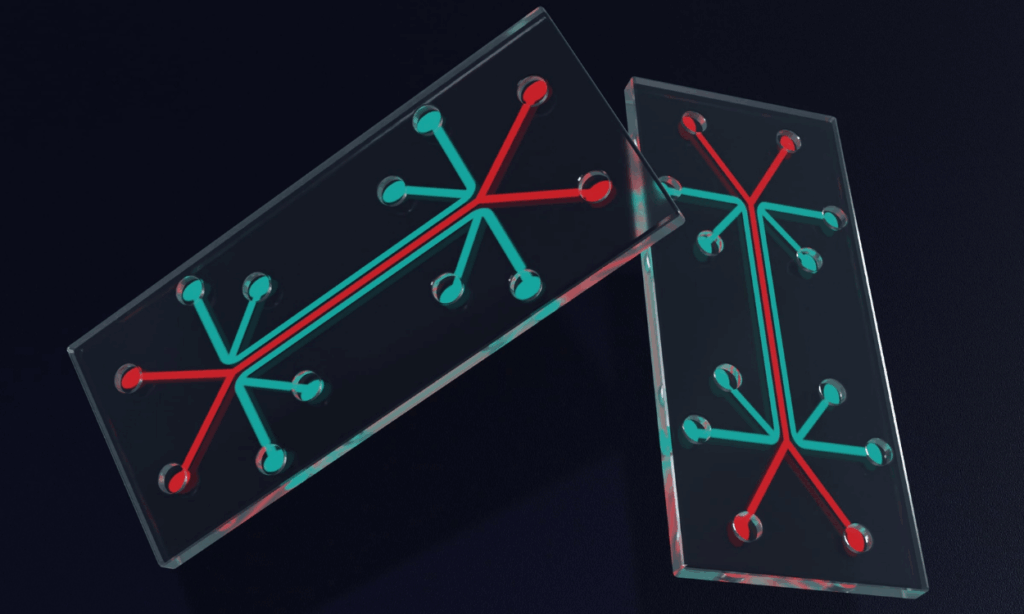
Pro Anima Scientific Committee: What do you consider to be the main scientific, technological, and regulatory challenges related to the development of OoCs, in France and internationally? What are the needs and prospects for standardization?
Jean-Dominique Guitton: The scientific challenges are to be able to model as many organs as possible, trying to associate them with other organs or other systems (vascular, immune, etc.) to get as close as possible to human physiological reality. It is also necessary to continue to demonstrate that these models are more predictive than animal models. The main technological challenges are standardization and automation. And among the regulatory challenges, it is particularly a question of simplifying access to the cells (healthy or pathological) essential for generating these models and obtaining from health authorities (ANSM, EMA) the acceptance of these models for use in medical research.
Franck Mouthon: The transition from basic research to its applications, whether industrial or directly integrated into healthcare practices, requires a sustained effort of standardization and normative change. The reproducibility of tools is indeed an essential condition for their recognition and integration. In certain emerging fields, such as organs-on-chips or organoids, the establishment of clear standards is an essential prerequisite, not only to ensure scientific robustness, but also to allow regulatory authorities to take an informed position.
In this regard, the APRS has a major advantage. Although it is affiliated with Inserm, it benefits from autonomous governance, structured around a partners’ committee bringing together, among others, all of the government’s health agencies and regulatory authorities (ANSM, HAS, ANSES, Santé publique France, among others). This configuration provides a unique framework for bringing regulatory stakeholders closer to the research front and enabling them to evolve their doctrines in line with scientific advances.
Finally, one of the APRS’s central vocations is to ensure the transferability of knowledge, whether through its dissemination to the general public, its adoption by political decision-makers, or its promotion in the economic world. This initiative directly contributes to France’s strategic positioning, whether it involves strengthening its health sovereignty, becoming a key interlocutor in international negotiations, or asserting itself as a leader in high-impact research areas. The partners’ committee constitutes, in this respect, an essential lever.
Pro Anima Scientific Committee: What are the respective objectives of the O&OoC sector and the APRS? How are they potentially complementary, also to those of the PEPR MED-OOC?
Jean-Dominique Guitton: The ambition of the French Organs-on-a-Chip sector is to structure and unite national expertise in order to position France as a pioneer in this strategic field. The success of this initiative will be measured through several concrete indicators:
- Job creation and economic development, through the emergence of innovative startups and their transformation into sustainable businesses;
- Increased availability of industrialized equipment, including chips, cells, specialized equipment, and the necessary software;
- Strengthened public-private collaborations, measured by the number of partnerships established, joint scientific publications, and connections with major national projects (such as PEPRs);
- The establishment of a qualification framework for OoOcs through the proposal of recognized norms and standards;
- International scientific influence, assessed by publication volume, H‑indexes (an index designed to quantify a scientist’s scientific productivity and impact based on the citation rate of their publications), recognition by French Key Opinion Leaders (KOLs), international collaborations, and attractiveness for foreign researchers and postdocs;
- Strengthening French sovereignty, illustrated by the number of patents filed and the ability to influence decisions related to clinical trials through the use of OOCs.
We are in close contact with the PEPR MED-OOC, which is part of our sector’s strategic committee.
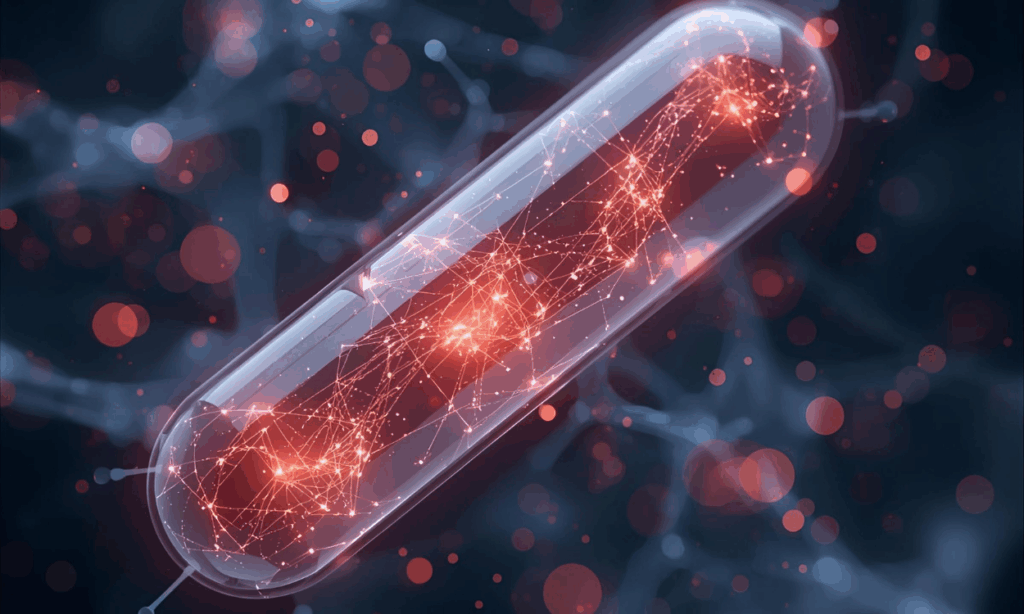
“One of the vocations of the APRS is the transferability of knowledge to the general public, public decision-makers, and the economic world”
Franck Mouthon
Franck Mouthon: Among the Agency’s partners, I was keen to integrate the O&OoC sector’s strategic committee. This allows us to draw on this already structured network. We also work with all the components of the healthcare industry—LEEM, CEA, France Biotech—which we mobilize to gain competitive intelligence and inform our thinking on program trajectories and attractiveness.
The Agency’s role is not to concentrate all expertise internally, but rather to build on the region’s existing strengths. The objective is to identify strengths and weaknesses, avoid duplication, and promote collaboration and synergy whenever relevant. In this regard, I would like to commend the remarkable work that has been accomplished around O&OoC: a strong dynamic and solid structure has emerged in France, constituting a particularly promising foundation.
At the Agency, we advocate for this sector to become a true national infrastructure for research and higher education, and even, in the long term, a European infrastructure. Despite some institutional reluctance, I remain convinced that this recognition is necessary to bring the sector the modernity, visibility, and attractiveness it needs. Attractiveness — industrial and scientific — is indeed one of the Agency’s core missions, through the leadership and strategic management entrusted to us.
I would, however, like to raise a question. Observing, on the one hand, the PEPR MED-OOC and the trajectories of the O&OoC, and on the other, the meteoric rise linked to artificial intelligence — whether generative AI applied to drug or vaccine discovery, or the exploitation of massive clinical data — a strategic question arises: how should organoids and organs-on-chips be positioned in this new landscape? Are these approaches at risk of being marginalized, or even made obsolete, by faster-than-expected technological shortcuts?
It is clear that O&OoCs still require development efforts to ensure consistency, robustness, and reproducibility. At the same time, they open up unique perspectives on certain vulnerable situations that are difficult to explore otherwise: in utero development, complex pathologies, aging, or early childhood. The latter case is particularly sensitive: the therapeutic needs for children are immense, yet manufacturers are reluctant to commit to pediatric investigation plans, fearing that failure would compromise their entire programs.
Therefore, a strategic avenue could be to convince regulatory authorities to accelerate the acceptance of these models in such contexts, provided their standards are established and their reliability demonstrated. These areas, where unmet needs are significant and alternatives are lacking, could offer a privileged environment to validate the usefulness and impact of O&OoCs. This requires quickly addressing issues related to acceleration, acceptability, and complementarity with animal models, while anticipating the clinical responses that these new tools could provide.
Pro Anima Scientific Committee: How do you assess France’s position today in terms of competitiveness and sovereignty (particularly in relation to the FDA’s recent announcements of the phasing out of animal testing and the creation of the NAM centre in the Netherlands and its public-private funding)?
Jean-Dominique Guitton: This is a question we must answer. We have many assets: public laboratories at the forefront of these technologies, innovative biotechs, and a desire for national structuring. We need to leverage all of this while integrating ourselves into European initiatives.
Franck Mouthon: I wouldn’t say in advance, because some countries like the Netherlands and Germany are already investing massively in these approaches by developing structured public-private partnerships. In the United States, recent decisions by the FDA and the NIH also point in this direction, authorizing certain accelerations based on these human-centered models, provided they are reproducible and validated.
The example of the Centre for Animal-free Biomedical Translation (Ombion) set up in the Netherlands illustrates this dynamic well: it is not a question of duplicating what already exists, but of working with them, identifying their positioning, and defining relevant complementarities or differentiations. These approaches are not played out at the national level, but rather at the European level. The key is therefore to coordinate, in order to have collective influence, while taking into account the rapid evolution of other technologies, notably artificial intelligence, which now considerably reduces the number of patients needed to demonstrate the effectiveness of a treatment.
Within the framework of the PEPR MED-OOC, the proposal to develop highly centralized and modular capabilities, similar to turnkey platforms, is particularly promising. In concrete terms, this would involve, for example, collecting cells from a child suffering from a rare disease, creating the corresponding organoids and organs-on-a-chip, carrying out in-depth characterization work, and personalizing the treatment. In terms of technological readiness levels (TRL), the Netherlands is positioned rather upstream, which validates the relevance of the choice made by the PEPR MED-OOC. However, this will need to be refined through the competitive intelligence currently being conducted, and the Agency will support this program to strengthen its attractiveness.
In this regard, the Agency relies on a European Operational Committee, whose ambition is to strategically position France on the themes deemed to be priorities. The objective is not to enter into head-to-head competition, but to identify teams with whom to build intelligent cooperation on a European scale, and to support themes that align with our social model and our strategic vision. The France Vaccins program is a good illustration of this type of initiative, designed from the outset for a European rollout.
Pro Anima Scientific Committee: Because these new tools generate a huge amount of data, we are also questioning the accessibility of this data within the Committee, particularly in the context of public-private partnerships. How can we better address this data accessibility issue, which is fundamental, especially in a multidisciplinary context?
Franck Mouthon: It’s a major regret to note that we haven’t moved faster on these issues. Accessibility to data, health data warehouses, and real-world data, which we will so desperately need to link in vitro observations to their consequences, are a central aspect of our mission. Even though we are due to enter the European Health Data Space (EHDS), coordination, streamlining, and acceleration are still not living up to their potential.
Within the Agency, with seven major programs to monitor, data sharing between programs represents a major challenge. We are fully aware of this and have integrated it from the very beginning, particularly in the Prevention program, which includes a focus on data governance.
“The ambition of the French Organs-on-a-Chip sector is to structure and unite national skills in order to position France as a pioneering player in this strategic field.”�
Jean-Dominique Guitton
Pro Anima Scientific Committee: In your opinion, what role will O&OoC play in biomedical research, drug development and in “personalized” medicine? As the validation/standardization of approaches can take more than 10 years, and new models can quickly render obsolete. How do you see this apparent temporal incompatibility?
Jean-Dominique Guitton: OoCs should help shorten the timeframes and reduce the costs of biomedical research by improving the results of preclinical research and making it more predictive and therefore more efficient. The complete replacement of animal testing still seems difficult to imagine, but if we test only on animals molecules that have shown efficacy and safety in human OoC models, the number of animals used should greatly decrease. We can also imagine that OoCs could be used to verify hypotheses proposed by AI.
Franck Mouthon: It is essential to break down the barriers between the worlds of technology and organs-on-chips. Given the rise of artificial intelligence and the acceleration of drug discovery, the urgent need is to identify areas where these models remain fully relevant, and those where we need to move beyond anticipation based on data alone. This is why I advocate focusing our efforts on vulnerable situations, which have so far been neglected by AI because they are deemed less economically sustainable, but which offer real potential for regulatory sustainability.
With this in mind, I will present all of the Agency’s programs at a seminar bringing together the regulatory teams who sit on our Partners Committee and are seeking knowledge on the most promising scientific fronts.
This issue is fundamental: in a democratic era marked by “post-truth”, where scientific discourse tends to become one opinion among others, the production and dissemination of robust knowledge, particularly on new technologies and advances in research, are more essential than ever.
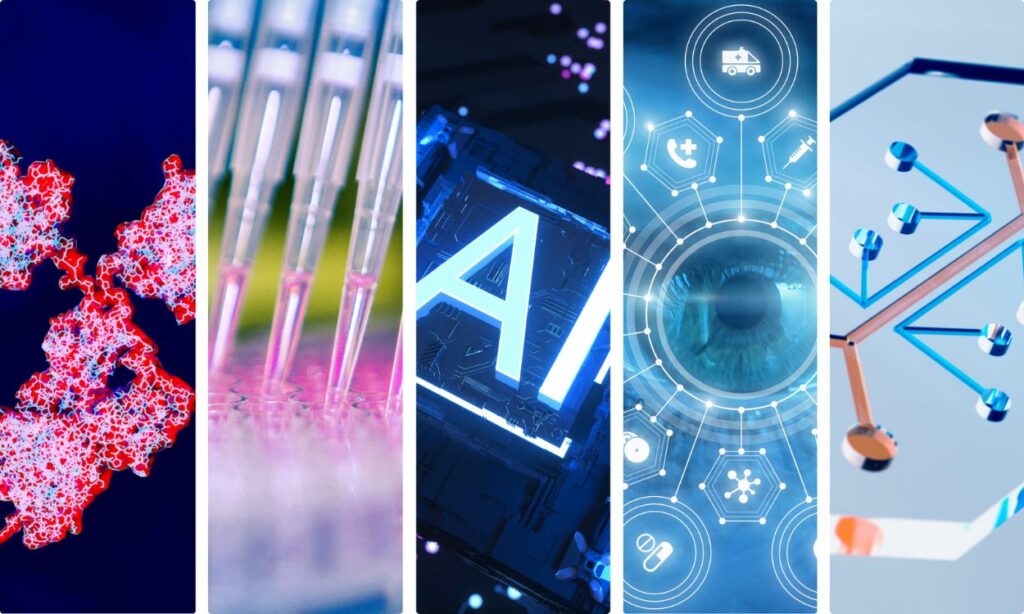
Pro Anima Scientific Committee: What future prospects would you like to see for health research, innovation, and public policy? How will your projects and the agency you represent contribute to this?
Jean-Dominique Guitton: The FDA’s recent incentives have helped break down barriers; France and Europe must follow suit, along with end users, the pharmaceutical industry for research into new drugs, and clinicians for personalized medicine. There is therefore a barrier of energy, acceptance, and investment, including financial, for these methods to become established. Structuring the sector in conjunction with academic and industrial stakeholders and government bodies should contribute greatly to this; that is our objective.
Franck Mouthon: I would like the APRS to eventually establish partnerships at the highest level with its foreign counterparts. This is absolutely essential: sharing our strategies, comparing our priorities, and becoming a key contact for major agencies programming research, particularly in health. The example of Switzerland is illuminating: this country of nine million inhabitants makes clear and efficient choices, which give it an influential role in the European scientific landscape.
Beyond the bottom-up dynamic that brings scientific frontiers to the forefront, it’s a matter of orchestrating intelligent prioritization around two or three promising programs, in order to position France with a genuine competitive advantage in the European context. But this ambition can only be realized if we overcome certain institutional postures, the fractures of which are costly and damaging, especially in the face of the rapid pace of research by countries like China or India. Structuring, coordinating and animating the ecosystem is therefore essential, as is recreating links, meaning and trust.
Trust, in fact, can only be rebuilt through transparency. All of the Agency’s choices are shared with the French health research community. This is the first step in restoring collective momentum. The next step is to invent smarter ways of working: programs designed as new ways of conducting research that are more horizontal, collaborative, open, and representative.
This is also why I am keen for the Agency’s impact to be measured by its ability to transfer its findings to public policy. Scientific research, information, and knowledge must once again become essential levers for informed decision-making, serving the major transitions we must support.
Finally, one issue is particularly close to my heart: the role given to younger generations of researchers. They are the ones who are driving innovative technologies, emerging topics, and the most dynamic approaches. In some major international programs, particularly in the Netherlands, work packages are entrusted to researchers aged 30 to 35. I hope that we will create a similar dynamic in France, because they are the ones who will write the research of tomorrow.
Jean-Dominique Guitton
Holding a PhD in Molecular Biophysics, Jean-Dominique Guitton has 30 years of experience in pharmaceutical research at Rhône Poulenc Santé and then at Sanofi-Aventis, where he held several Department Director positions (Protein Production and Engineering, Lead Discovery Technologies, Biologics Generation). He joined the BioValley France Cluster in 2014 through a Sanofi skills sponsorship. Jean-Dominique is primarily responsible for the Cluster’s strategic missions. He represents the Cluster in the operational group of the Strategic Sector Council on Disruptive Technologies in Bioproduction and is also co-lead of the creation of the French organ-on-chip sector.
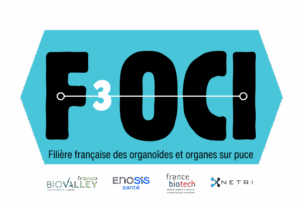
Franck Mouthon
A former student of the École Normale Supérieure (ENS), Franck Mouthon led a research team at the CEA for around ten years. In 2013, he chose the path of entrepreneurship, co-founding, alongside Mathieu Charvériat, the company Theranexus, a company focused on the design and development of drug candidates to treat rare pediatric neurological diseases. In September 2019, he was elected President of France Biotech, an independent association that brings together healthcare innovation entrepreneurs (biotech, medtech, digital health). Franck Mouthon was also designated a qualified individual on the monitoring committee of the France 2030 Health Innovation Plan. In April 2024, Franck Mouthon was appointed Executive Director of the Health Research Program Agency.
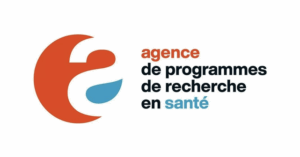
Read More
APRS
Additional interview
Franck Mouthon: “These agencies, each assigned to a national research organization (ONR) in its area of expertise, are tasked with identifying priority themes and building major national programs such as PEPR (Priority Research Programs and Equipment). These programs are characterized by a duration of 4 to 5 years, the involvement of several—sometimes dozens—of teams, ideally gender-balanced and intergenerational, and budgets ranging from €10 million to €100 million. They are based on an integrative, interdisciplinary, participatory, and interoperable approach, particularly with regard to data.
The objective is in no way to undermine open, bottom-up research, essential due to its exploratory and risky nature, but rather to align it with a strategic vision. The APRS should thus make it possible to bring together research forces around major issues and contribute to the national response to major transitions.”
Over the past year, we have identified and submitted three priority themes to the State, which have been selected and will be funded: a program on neurodegenerative diseases, whose objective is to identify common determinants in the prodromal phases of pathologies such as Alzheimer's and Parkinson's, by mobilizing healthcare data and existing cohorts. This approach aims to enable early intervention to improve the detection, targeting, and treatment of these diseases. Another program concerns chronic inflammatory diseases, understood via a transnosographic approach in order to identify the determinants of chronicity and intervene early. A program dedicated to transplantation and regenerative medicine aims to give France a strategic advantage, by capitalizing on recent scientific advances in the use of artificial intelligence to optimize compatibility between donors and recipients. It also aims to develop European hubs combining biology and AI, in order to extend this dynamic to different types of transplants and to consolidate French scientific and medical leadership in this field.
In addition, there is an interdisciplinary program on the end of life, led by the Agency, which is part of a major societal transition, dedicated to the end of life and the management of suffering in all its dimensions. It also aims to better anticipate entry into care pathways and to reduce health inequalities that are particularly marked in our country. The France Vaccins program aims to give France a voice in international competition, and to lead programs that range from TRL (Technology readiness level) 3 to 4, i.e. the first target of a vaccine candidate, to the demonstration of clinical value, thus being able to be purchased by States or by manufacturers.
Finally, a particularly ambitious program concerns prevention. This is the first program of this scale in France specifically dedicated to this field. Structured around two cross-cutting axes – the study of the exposome and health determinants as well as the analysis of preventive interventions and behaviors – it is also deployed through four demonstrator axes: the first 1,000 days until adolescence, respiratory diseases, addictions, as well as relapse and long-term monitoring of cancers. The program will attempt to provide the missing data to be able to drive a return on investment in public policies in prevention.”





